Despite all that discussion and awareness of the typewriter as a tool referred to in my previous post, before Jack Kerouac no writer to my knowledge had addressed one specific aspect of what we might call the typewriting experience for the writer: the interruption of one’s train of thought by the need to replace one sheet of 8-1/2 x 11″ paper with another according to a mechanical system that had absolutely nothing to do with the structure of that thought in the process of its expression.
You took a sheet of paper out, you laid it aside, you picked up a blank sheet. You tucked it into the narrow space between the platen — a horizontal rubber cylinder that cushioned the impact of the keys striking on the paper — and a backrest. You cranked the paper forward several inches, either by hand (via a knob or the carriage-return lever on a manual machine) or else by hitting the return key (on some models of electric ones), until its top edge could get held down against the platen by a small rod that had to get positioned by hand. Usually it went smoothly; sometimes it didn’t, and then you fussed with it till you got it right. After that you continued.
I wrote on manual and electric typewriters for 35 years, and got about as fast at that procedure as any full-time writer would. So I can testify from personal experience that no matter how fluid one became at performing it, this constituted at least a 15-second interruption in the flow of one’s ideation and emotional involvement with the emerging text. It happened in mid-essay or poem or story or chapter, in mid-paragraph, in mid-sentence. And, inevitably, in mid-thought.
It not only resulted regularly in loss of one’s train of thought, especially grating if one was at white heat and the replacement process didn’t go smoothly, but it encouraged distraction, for which most who write need no further excuse. Putting in the new sheet, accepting that unavoidable break in the rhythm, often became the occasion for sitting back in one’s chair, lighting up a cigarette, going to the bathroom, putting on the coffeepot, knocking off for the afternoon, or otherwise letting go of the moment of invention.
Of course one got so used to it that it became subliminal as experience (like dipping a pen in an inkwell, as I did in my childhood in France). One rarely considered it, never talked about it, took it for granted as a necessary part of the process. However, unless one worked exclusively in short forms that would fit on a single page (such as the sonnet or other forms of lyric poetry), it lurked in the awareness and constituted an impediment. Not simply a limitation, such as the 3-1/2-minute duration of the 10-inch 78-rpm record, which for some four decades dictated to composers of popular song the optimum length of a composition, or the half-hour maximum of the standard 33-1/3 “longplay” record, which expanded that.
Limitations can spur creativity; Shelley wrote that he found in the seeming constraints of sonnet form “not chains but wings.” No such benefits accrued from changing paper in the typewriter. For anyone whose execution of a written idea would extend past a single sheet of paper, the 8-1/2 x 11 page became an interference in the workflow — an obstacle, and a technologically based one.
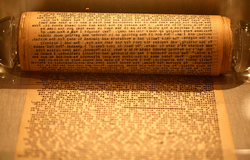
Jack Kerouac, scroll of On the Road. Photo used courtesy of a Creative Commons license from Thomas Hawk.
Kerouac’s invention of the scroll as alternative needs to get seen as just that — not an eccentricity or a self-indulgence or an affectation but an invention, a technological one, as radical in its way as the invention by hip-hop deejays of the use of stereo-system turntables and LP records for “scratching.”
Kerouac had obviously experienced the interruption of thought occasioned by the limitations of the typewriter. He took the improvisations of jazz musicians as a model for his writing; perhaps he experienced this as akin to what a jazz musician would feel if asked to hold her solo in mid-phrase while she or someone else adjusted the microphone. Kerouac devised a technological solution, elegant in its simplicity and economy (including its financial cost). Like the hip-hop deejays, he did not create a new technology; instead, he repurposed an existing one, using its capacity to achieve something its inventors and manufacturers had not imagined.
My point: Kerouac understood the typewriter as a tool and as a technology, brought his relationship to it from the unarticulated to full consciousness, recognized its negative consequences for his writing process, and creatively adapted or modified it to suit his purposes. This could only have resulted from a full Buddhistic “being here now” engagement with the writing experience, an alertness to the actual practice of writing as both a psychological and physical experience, an attunement to the natural rhythm of one’s writing energy and a consequent noting of anything that got in the way thereof.
Considered as a technological invention, what Kerouac’s typewriter-plus-scroll prefigures is . . . the word-processor document file. A space for writing as open and lengthy as you want it to be. Automatic word-wrap, automatic pagination, a new “page” within the document as soon as your text overruns the last one, nothing to get in the way of the pulsing of your words and the evolution of your idea. No instrument has ever offered a better performance space for “spontaneous bop prosody.”
The fact that no other writers adopted Kerouac’s production system — not even those who accepted his “spontaneous bop prosody” as a methodology — suggests that the notoriety that became attached to his invention made it seem somehow proprietary to Kerouac, as if anyone else using it would appear as a mere imitator. They missed the point, methinks.
I don’t believe that Kerouac himself had any possessive relationship to this method, or thought of it as “his” in that sense. He had a problem, a technological problem that a writer (but only a writer of a certain bent, and one with a deep awareness of process) would recognize. He solved it, not by adjusting his writing style to the Procrustean bed of standard typewriter usage but by rethinking and altering the tools and materials with which he wrote.
Kerouac continued to use this invention (he wrote his 1959 book The Dharma Bums that way), but he never promoted the idea or made much of it in discussing his working method. Anyone else could have duplicated it, had they treated it as open-source shareware (so to speak) rather than proprietary. His analysis of the issue, and his response to it, points any thoughtful writer toward the question of how the chosen tools of one’s craft shape and even determine the ways in which one works and the kind of work one produces, and thus to the biases built into that technology (and, by implication, into any technology) by its inventors, designers, and manufacturers and imposed on that technology’s users as defaults.
That was indeed, as Truman Capote said without realizing the true import of his words, “not writing but typing.” Kerouac had manifested a profound, nuanced understanding of what it meant to write on a typewriter. It was also extremely creative thinking, the revamping of a technology to suit one’s own purposes. Time for us to give Kerouac credit for that.
Today’s writers, especially those young enough to have worked all their lives on computers using word-processing applications, do not have the physical experience of working on typewriters that would enable them to understand that writing was once a material process that required activity of various kinds in the material world, not just a keyboard and screen and CPU. Those primitive word-processing programs like WordStar, Electric Pencil, EasyWriter, all built on Kerouac’s idea of the scroll, whether their developers knew it or not. They relinquished the 8-1/2 x 11″ (or A4) page as the defining unit of the writing space, defaulting instead to an unlimited, continuously expanding storage space for text whose confines the writer would decide upon when the writing was done. A writing machine worthy of a Kerouac.
Postscript
I wrote my initial draft of these first two parts of this series several years ago in Steve St. Laurent’s Stories & Sources, a FileMaker Pro 9-based writing environment. It’s still available, priced at $39.95, but St. Laurent stopped evolving it with FMPro iteration 8.5, circa 2007; that app’s now at release 12. Subsequently I evolved my own version of an FMPro writing environment, revamping an open-source Filemaker “solution,” adding to it ideas of my own plus some I’d drawn from my experiences, pro and con, with St. Laurent’s approach.
Unlike most word-processing programs, FileMaker Pro does not even break down one’s text into page units. It offers (hey there, Charles Olson) what FMPro developers and users call a field — and an open one, to boot — for my prose. Moreover, as I compose that writing and it grows, I get to key text into it uninterruptedly for as long as I want, and scroll (hi, Jack) through it as a continuous whole, while FMPro autosaves everything I input. Feels sometimes as if those gents look over my shoulder and nod appreciatively. Not at my writing, which they might not care for, but at the toolkit at my disposal.
•
This post supported by a donation from the Estate of Lyle Bongé.



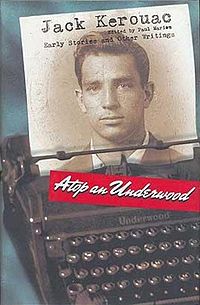
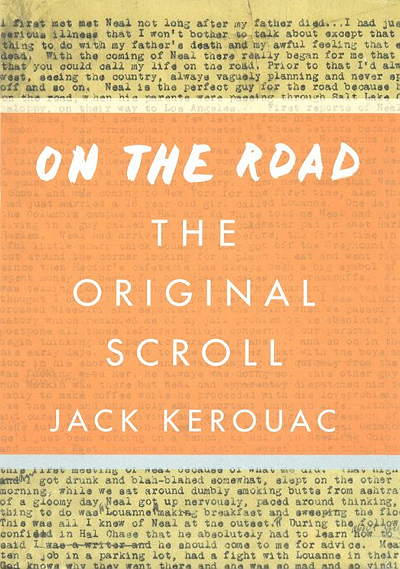
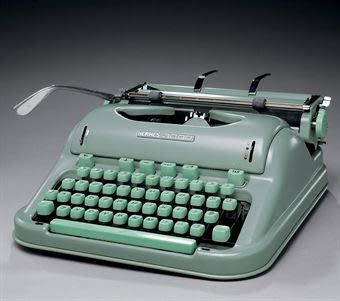
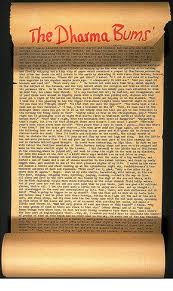
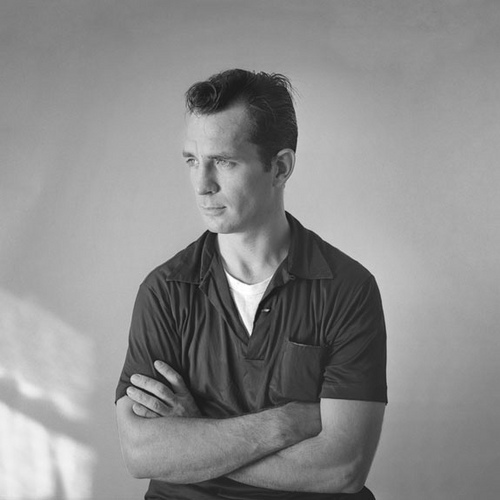
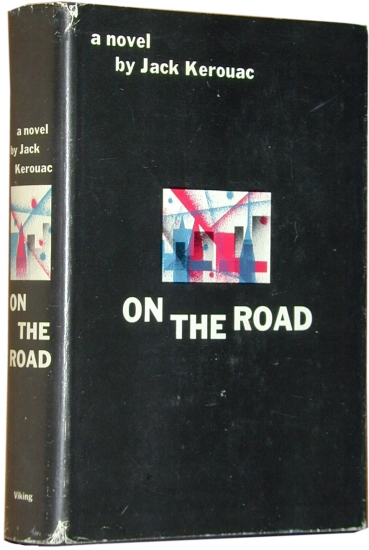
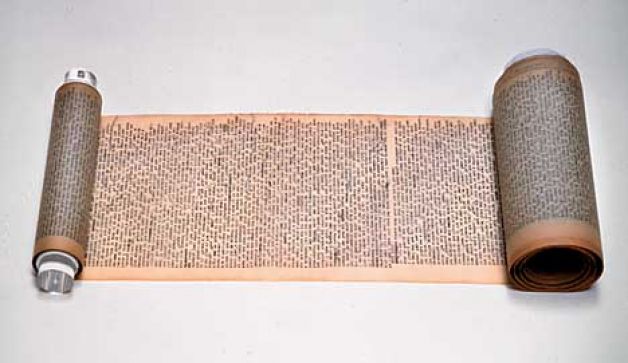




Two thoughts Allan,
Kafka said about typewriters, after trying one for awhile: “these machines are changing the thoughts we think.” Or words to that effect.
Kerouac was in the Navy or the Coast Guard during WW 2 and doubtless was familiar with teletype machines and their long rolls of paper. When as a teenager I worked as an intern in the news department at the Pacifica radio station we referred to getting news off of the UPI teletype as “rip & read.” One of my jobs (and one of the more fascinating ones) at KPFT was to go through through the long”scrolls”which had accumulated and look for items I thought would be of interest to Mitch Green (news), the station manager, or Jeff Shero before he turned himself into Jeff Nightbyrd and moved back to Austin.
Ellis
Thanks for the Kafka paraphrase. I’ve tried to track down the precise quote, and I find references to it but not the quote itself. Notably, he had a lengthy affair with Felice Bauer, a typist at a Berlin typewriter company, to whom he was engaged twice. The quote apparently comes from a letter he wrote to her.
Kerouac enlisted in the U.S. Naval Reserve in December 1942, but flunked boot camp and was honorably discharged. Unlikely that he encountered teletype machines during that period. He did serve briefly in the U.S. Merchant Marine, and may have encountered them on shipboard there, or during the period when he worked for the Southern Pacific railroad.
However, teletype machines were relatively common at that time. The Mokrum Model 12 Page Printer, based on an Underwood typewriter mechanism, was the first commercially viable machine. (Kerouac’s first typewriter was an Underwood, coincidentally.) Government and corporate offices — probably also the Merchant Marine offices, and the Seaman’s Union headquarters — often had such devices on hand. Radio news shows frequently featured the sound of the machine (like a fast typewriter) as intro and background sound. Newsreels did the same, as did Hollywood movies, often showing the machines in action. So Kerouac wouldn’t have had to actually encounter a teletype machine firsthand to get inspired thereby.
All of these devices used long rolls of paper instead of sheet-fed systems. That raises an interesting question. Rolls of teletype paper, the same 8-1/2″ width as standard typing paper, were readily available and inexpensive in office-supply stores in the 1950s. Why didn’t Kerouac just buy one of those, instead of cutting to size and taping together pieces of tracing paper? The most likely answer is that, even if the image of the teletype printer had triggered his conception, that had happened unconsciously, so it hadn’t occurred to him to look for an existing roll that would suit his needs.
This is especially brilliant — I can always rely on you to open new synapses and re-introduce me to myself, the creative process and how I work and think. . . .
xo Mary Ann
That “On the Road” scroll looks suspiciously like a Torah. And I have to agree with Truman: it’s typing.
It does look like a Torah (but also like every other form of ancient scroll). Kerouac having no particular fondness for those of the Hebrew persuasion, I doubt any specific influence on him from that source.
As for Capote’s view of Kerouac’s work: The latter has grown in his influence on literature specifically and culture generally. His works are studied by scholars, and by other writers. Conversely, the writer a mutual friend of yours and mine referred to as Truman Compote (“a small bowl of stewed fruit”) never exerted much influence on other writers or artists. His claim to invention of the “nonfiction novel” form for In Cold Blood (1966) is arguable — others had preceded him — but the book is considered a classic in the “true crime” genre. Aside from that achievement, as a contributor to culture he’s remembered (if at all) as the author on whose fey novel the movie Breakfast at Tiffany’s was based.
If that’s writing versus typing, I’ll take typing any day.